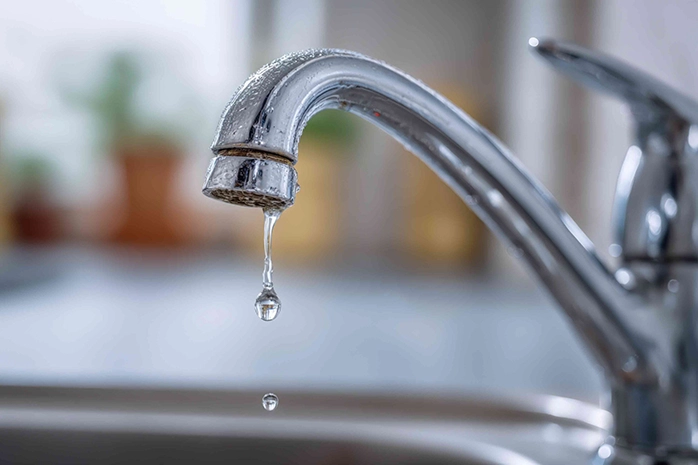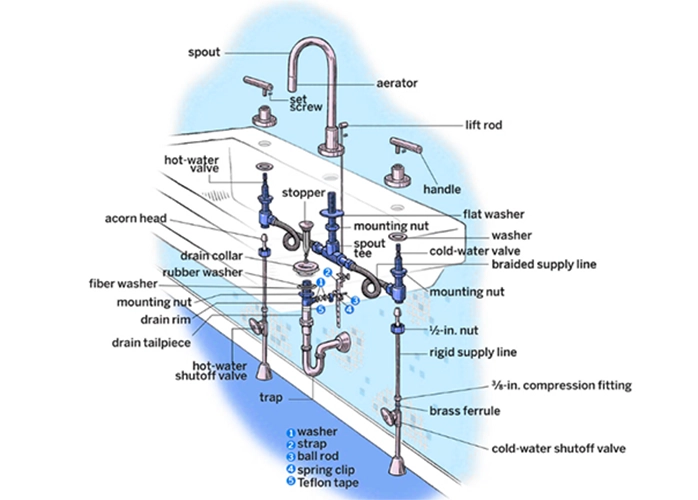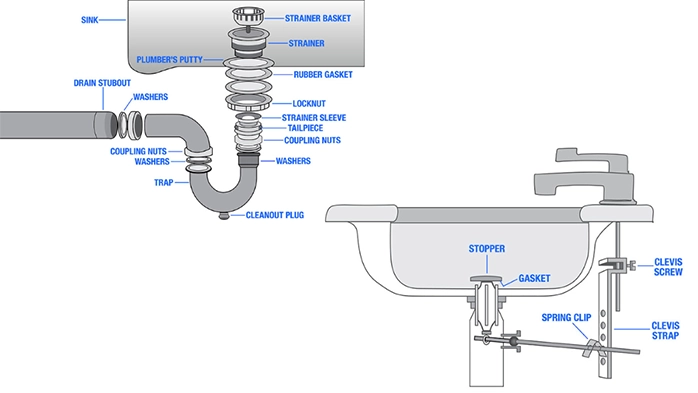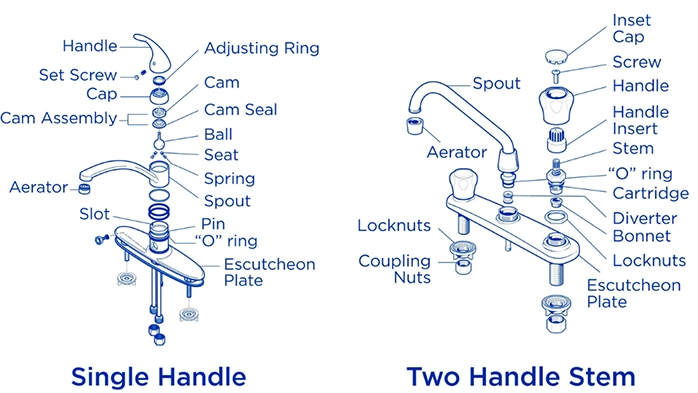
Most of us use our sinks several times a day without thinking about what’s actually going on behind the scenes. But when something starts dripping, gurgling, or just stops working, knowing how to replace your sink parts becomes pretty important…
Everything You Need to Know About the Parts of a Sink
In this guide, we’ll break down everything you need to know about the different parts of a sink, so you can grab the right parts, talk to plumbers without feeling lost, and maybe even fix some simple issues yourself!
The 5 Main Components Every Sink Has

1. Basin
The basin is the bowl part that holds water. It’s what you see when you look at any sink: round and shallow for bathrooms, larger and deeper for kitchens. Most are made from stainless steel, porcelain, or composite materials because they’re durable and easy to clean. The basin connects to your drain system at the lowest point.
2. Faucet Assembly
The faucet controls your water flow and temperature. It includes the spout where water comes out, the handles you turn, and internal parts that mix hot and cold water. Single-handle faucets control everything with one lever, while two-handle faucets have separate controls for hot and cold water.
3. Drain Opening
The drain is the hole at the bottom of the basin where water exits. Kitchen sink drains are typically larger (about 3½ inches) to handle food debris, while bathroom sinks have smaller openings (about 1¼ inches). Most include a removable strainer to catch debris before it enters your pipes.
4. Water Supply Lines
These are the flexible braided tubes under your sink that bring fresh water to your faucet. They connect your home’s main plumbing to your individual sink.
5. Shut-off Valves (Angle Stops)
Located under the sink where supply lines meet the wall, these valves let you turn off water to just your sink without affecting the rest of your house. Turn them clockwise to close, counterclockwise to open. Every sink should have two (one for hot and one for cold water)
Faucet Parts Diagram Showing the Difference Between Single and Two-handle Sinks
SINGLE-HANDLE FAUCET COMPONENTS
|
TWO-HANDLE FAUCET PARTS
|
Understanding Your Sink Drainage System
Most people don’t realize just how complex a sink drain assembly actually is. Sure, some components like plumber’s putty and locknuts are fairly straightforward, but there’s much more to your sink’s drainage system than meets the eye. Let’s break down the key components you should know about:
Visible Drain Parts
- Strainer Basket: The removable part that sits in your drain opening to catch food, hair, and debris. Kitchen strainers are larger and handle food waste, while bathroom strainers have finer holes for hair and soap buildup.
- Drain Flange: The metal ring that sits flush with your sink bottom around the drain opening. It provides a finished look and creates the seal between your sink and the drain system below.
Hidden Drainage Components
- Drain Body: The threaded part directly under your sink that connects the visible drain to the pipes below. This is where the strainer basket sits and where everything connects.
- Tailpiece: The straight pipe that connects your drain to the curved pipe below. Water flows down through this after leaving the sink. It’s usually 6-12 inches long depending on your setup.

Other Components of Your Drainage System
P-Trap
The curved pipe shaped like a “P” or “U” that holds water to block sewer gases. This curve also catches debris, which is why most sink clogs happen here. The P-trap can be removed for cleaning – just put a bucket underneath first.
Trap Arm
The horizontal pipe that goes from the P-trap into the wall, carrying wastewater to your home’s main drainage system. This pipe slopes downward to keep water flowing in the right direction.
Slip Joints
The connections between P-trap sections that can be loosened for cleaning. They include nuts and washers that create watertight seals while allowing easy removal.
How Your Sink Drain Assembly Works
Understanding how all these sink parts work together helps when something goes wrong:
- Water Control: Turn the faucet handle to open internal valves
- Temperature Mixing: Hot and cold water mix inside the faucet cartridge or valve system
- Water Delivery: Mixed water flows through the spout and aerator into your sink
- Waste Collection: Used water and debris flow toward the drain opening
- Debris Filtering: The strainer basket catches larger items while water passes through
- Initial Drainage: Water flows through the drain body and down the tailpiece
- Gas Blocking: Water passes through the P-trap, which maintains a water seal against sewer gases
- Final Disposal: The trap arm carries water into your home’s main drain system
Quick Reference Glossary
Let’s quickly review the names of sink parts and their functions before you go. Keep this handy as a reference guide:
Aerator
The small screen that screws into the spout tip. It mixes air with water to reduce splashing, save water, and create a smooth flow. When this gets clogged with minerals, your water pressure drops.
Basin
The bowl part of your sink that holds water. Round and shallow for bathrooms, larger and deeper for kitchens. Made from stainless steel, porcelain, or composite materials for durability and easy cleaning.
Cartridge
The internal mechanism inside single-handle faucets that controls both water flow and temperature mixing. When you move the handle, it adjusts the cartridge position to change how much hot and cold water mix together.
Drain
The hole at the bottom of your sink basin where water exits. Kitchen drains are larger (about 3½ inches) while bathroom drains are smaller (about 1¼ inches). Usually includes a removable strainer to catch debris.
Faucet
The complete water delivery system including the spout, handles, and internal mixing components. Controls both water flow rate and temperature through either single-handle or two-handle operation.
P-Trap
The curved pipe under your sink shaped like a “P” or “U”. Holds standing water that prevents sewer gases from entering your home. Also catches debris, which is why most sink clogs happen here.
Shut-off Valves (Angle Stops)
Individual water controls located under your sink where supply lines connect to the wall. Let you turn off water to just your sink without affecting the whole house. Turn clockwise to close, counterclockwise to open.
Supply Lines
Flexible braided tubes that carry fresh water from your home’s main plumbing to your faucet.
Tailpiece
The straight vertical pipe that connects your sink drain to the P-trap below. Water flows down through this pipe after leaving your sink basin.
Trap Arm
The horizontal pipe that carries wastewater from your P-trap into the wall drain, connecting your sink to your home’s main drainage system.
Valve Stems
Internal mechanisms inside two-handle faucets that control hot and cold water separately. Each handle operates its own valve stem to open and close water flow.
Washers
Small rubber sealing pieces in two-handle faucets that create the watertight seal when you turn off the water.
Tap Out? We’ll Tap In
Got sink problems? Contact a professional plumbing company like Maplewood Plumbing. We’ll handle the messy work so you don’t have to.
Comments are closed



